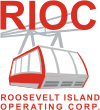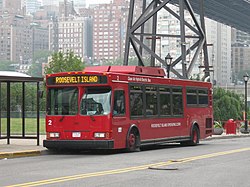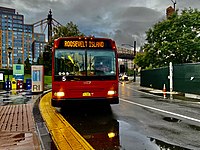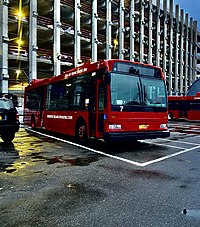
Roosevelt Island is an island in New York City's East River, within the borough of Manhattan. It lies between Manhattan Island to the west, and the borough of Queens, on Long Island, to the east. It is about 2 miles (3.2 km) long, with an area of 147 acres (0.59 km2), and had a population of 11,722 as of the 2020 United States Census. It consists of three largely residential communities: Northtown, Northtown II, and Southtown. Roosevelt Island is owned by the city but was leased to the New York State Urban Development Corporation (UDC) for 99 years in 1969.
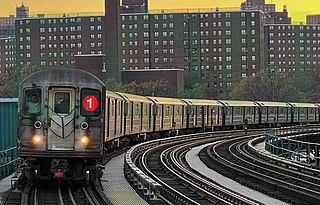
The New York City Subway is a rapid transit system in the New York City boroughs of Manhattan, Brooklyn, Queens, and the Bronx. It is owned by the government of New York City and leased to the New York City Transit Authority, an affiliate agency of the state-run Metropolitan Transportation Authority (MTA). Opened on October 27, 1904, the New York City Subway is one of the world's oldest public transit systems, one of the most-used, and the one with the most stations, with 472 stations in operation.

The Staten Island Railway (SIR) is a rapid transit line in the New York City borough of Staten Island. It is owned by the Staten Island Rapid Transit Operating Authority (SIRTOA), a subsidiary of the Metropolitan Transportation Authority, and operated by the New York City Transit Authority Department of Subways. SIR operates 24 hours a day, seven days a week, providing local service between St. George and Tottenville, along the east side of the island. There is currently only one line on the island, and there is no direct rail link between the SIR and the New York City Subway system, but SIR riders do receive a free transfer to New York City Transit bus and subway lines, and the line is included on official New York City Subway maps. Commuters on the railway typically use the Staten Island Ferry to reach Manhattan. The line is accessible from within the Ferry Terminal, and most of its trains are timed to connect with the ferry. In 2023, the system had a ridership of 6,151,400, or about 19,500 per weekday as of the fourth quarter of 2023.

The Metropolitan Transportation Authority (MTA) is a public benefit corporation responsible for public transportation in the New York City metropolitan area of the U.S. state of New York. The MTA is the largest public transit authority in North America, serving 12 counties in Downstate New York, along with two counties in southwestern Connecticut under contract to the Connecticut Department of Transportation, carrying over 11 million passengers on an average weekday systemwide, and over 850,000 vehicles on its seven toll bridges and two tunnels per weekday.

The Roosevelt Island Tramway is an aerial tramway that crosses the East River in New York City, connecting Roosevelt Island to the Upper East Side of Manhattan. The tramway is the first commuter aerial tramway in the U.S., having opened on May 17, 1976, to serve residential developments on the island. The tram is operated by Leitner-Poma on behalf of the Roosevelt Island Operating Corporation of the State of New York.
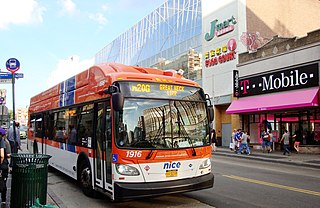
The Nassau Inter-County Express (NICE) is the local bus system serving Nassau County, New York. It also serves parts of western Suffolk County, New York as well as eastern portions of the New York City borough of Queens. It was formerly operated under the name of MTA Long Island Bus, the trading name of the Metropolitan Suburban Bus Authority, a division of MTA Regional Bus Operations. In 2011, the owner, Nassau County, decided to outsource the system to a private operator, Veolia Transport, due to a funding dispute with the MTA.

The New York Transit Museum is a museum that displays historical artifacts of the New York City Subway, bus, and commuter rail systems in the greater New York City metropolitan region. The main museum is located in the decommissioned Court Street subway station in Downtown Brooklyn and Brooklyn Heights in the New York City borough of Brooklyn. There is a smaller satellite Museum Annex in Grand Central Terminal in Midtown Manhattan. The museum is a self-supporting division of the Metropolitan Transportation Authority.
The New York Power Authority (NYPA), is the largest state public power utility in the United States providing some of the lowest-cost electricity in the nation, operating 16 generating facilities and more than 1,400 circuit-miles of transmission lines. Its main administrative offices are in White Plains, New York
New York state public-benefit corporations and authorities operate like quasi-private corporations, with boards of directors appointed by elected officials, overseeing both publicly operated and privately operated systems. Public-benefit nonprofit corporations share characteristics with government agencies, but they are exempt from many state and local regulations. Of particular importance, they can issue their own debt, allowing them to bypass limits on state debt contained in the New York State Constitution. This allows public authorities to make potentially risky capital and infrastructure investments without directly putting the credit of New York State or its municipalities on the line. As a result, public authorities have become widely used for financing public works, and they are now responsible for more than 90% of the state's debt.
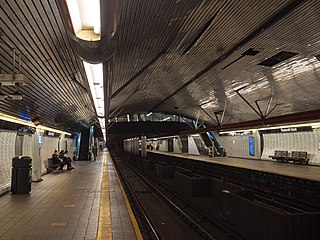
The Roosevelt Island station is a station on the IND 63rd Street Line of the New York City Subway. Located in Manhattan on Roosevelt Island in the East River, it is served by the F shuttle train at all times except late nights.

Queens Surface Corporation was a bus company in New York City, United States, operating local service in Queens and the Bronx and express service between Queens and Manhattan until February 27, 2005, when the MTA Bus Company took over the operations. The company was known for its orange paint scheme, used since the company's inception in the late 1930s.

The Jackson Heights–Roosevelt Avenue/74th Street station is a New York City Subway station complex served by the IRT Flushing Line and the IND Queens Boulevard Line. Located at the triangle of 74th Street, Broadway, and Roosevelt Avenue in Jackson Heights, Queens, it is served by the 7, E, and F trains at all times; the R train at all times except late nights; and the <F> train during rush hours in the reverse peak direction.
An automated vacuum waste collection system, also known as pneumatic refuse collection, or automated vacuum collection (AVAC), transports waste at a high speed through underground pneumatic tubes to a collection station where it is compacted and sealed in containers. When the container is full, it is transported away and then emptied. The system helps facilitate the separation and recycling of waste.
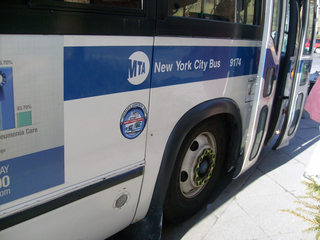
MTA Regional Bus Operations operates local and express buses serving New York City in the United States out of 29 bus depots. These depots are located in all five boroughs of the city, plus one located in nearby Yonkers in Westchester County. 21 of these depots serve MTA New York City Transit (NYCT)'s bus operations, while the remaining eight serve the MTA Bus Company These facilities perform regular maintenance, cleaning, and painting of buses, as well as collection of revenue from bus fareboxes. Several of these depots were once car barns for streetcars, while others were built much later and have only served buses. Employees of the depots are represented by local divisions of the Transport Workers Union of America (TWU), particularly the TWU Local 100 or of the Amalgamated Transit Union (ATU)'s Local's 726 for all depots in Staten Island, 1056 for Casey Stengel, Jamaica, and Queens Village Depots, 1179 for JFK & Far Rockaway Depots, and 1181 for Spring Creek Depot.

The Roosevelt Island Public Safety Department (RIPSD) in New York City provides safety and security service to residents of Roosevelt Island, and the Manhattan and Roosevelt Islands stations of the Roosevelt Island Tramway, because of the contract that the State of New York made with New York City in 1968 which gave the state a 99-year lease on the land.

MTA Regional Bus Operations (RBO) is the surface transit division of the Metropolitan Transportation Authority (MTA). It was created in 2008 to consolidate all bus operations in New York City operated by the MTA. As of February 2018, MTA Regional Bus Operations runs 234 local routes, 71 express routes, and 20 Select Bus Service routes. Its fleet of 5,840 buses is the largest municipal bus fleet in the United States and operates 24/7. In 2023, the system had a ridership of 730,924,600, or about 2,309,600 per weekday as of the fourth quarter of 2023.

The Q60 bus route constitutes a public transit line running primarily along Queens Boulevard in Queens, New York City, extending from Jamaica, Queens, to Midtown Manhattan via Queens Boulevard and the Queensboro Bridge. It is city-operated under the MTA Bus Company brand of MTA Regional Bus Operations.

The New York City Board of Transportation or the Board of Transportation of the City of New York was a city transit commission and operator in New York City, consisting of three members appointed by the mayor. It was created in 1924 to control city-owned and operated public transportation service within the New York City Transit System. The agency oversaw the construction and operation of the municipal Independent Subway System (IND), which was constructed shortly after the Board was chartered. The BOT later presided over the major transfers of public transit from private control to municipal control that took place in the 1940s, including the unification of the New York City Subway in 1940. In 1953, the Board was dissolved and replaced by the state-operated New York City Transit Authority, now part of the Metropolitan Transportation Authority (MTA).
OMNY is a contactless fare payment system, currently being implemented for use on public transit in the New York metropolitan area. OMNY can currently be used to pay fares at all New York City Subway and Staten Island Railway stations, on all MTA buses, AirTrain JFK, Metro North's Hudson Rail Link, and on the Roosevelt Island Tram; when completely rolled out, it will also replace the MetroCard on Bee-Line buses, and NICE buses. OMNY will also expand beyond the current scope of the MetroCard to include the Long Island Rail Road and Metro-North Railroad.
